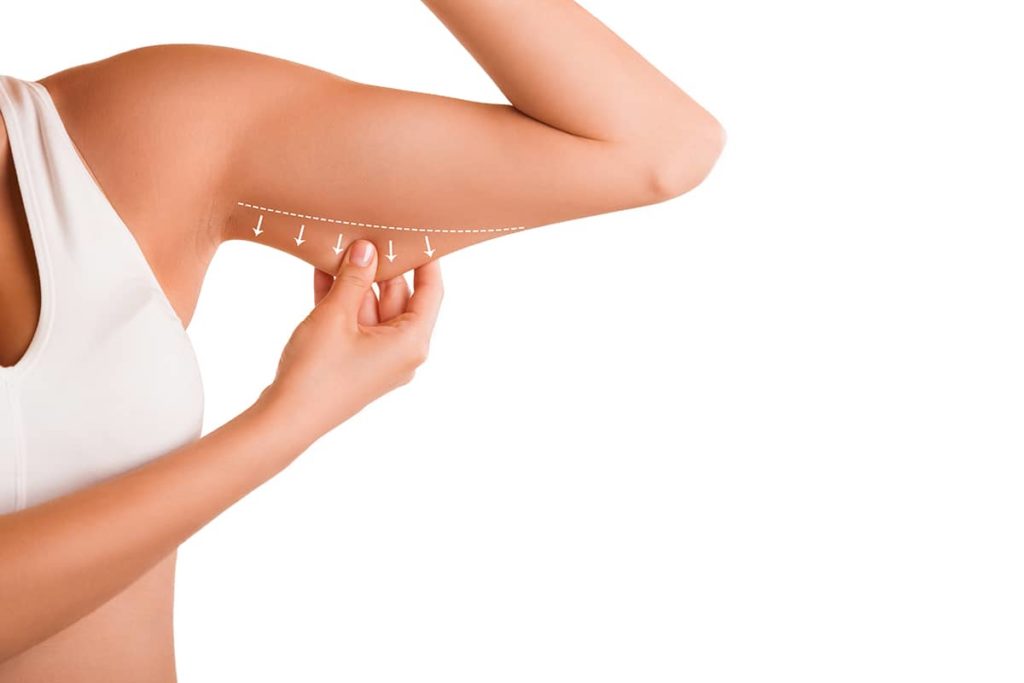Are you bothered by lack of upper arm definition?
Do you avoid wearing certain dresses or tops because you are self-conscious about the way your arms look in them?
Do you find yourself posing in photographs to hide the appearance of your upper arms?
Men, do you avoid wearing tank tops or are you self-conscious with your shirt off because you are worried about the appearance of arms?

Dissatisfaction with upper arm definition is a very common aesthetic complaint, and one that we are seeing more frequently in our clinic. We see this concern in both men and women, and across nearly all adult age groups. Whether the problem is just a little extra localized layer of fat or the primary problem is excess skin, this stubborn area is very often resistant to improvement with diet and exercise. Even the strictest, most dedicated diet and exercise regimen may not get the upper arm and shoulder results that patients desire. Unfortunately, this problem area is often due to genetics. Patients can be very self-conscious about their arms and will limit types of clothing they wear because they don’t like the way their arms look or don’t want their arms to show. Some patients will even avoid going out in certain scenarios altogether, such as a summer pool party for example.
What options do I have to improve the contour of my arms?
For those patients who feel that they have reached a plateau with diet and exercise and want a little extra help, the good news is that there are surgical options that can provide a little extra assistance toward achieving your aesthetic goals. The two most commonly utilized surgical modalities used to address arm definition are liposuction and brachioplasty (also known as arm lift), or occasionally, a combination of both. Surgical treatments for upper arm definition have grown in popularity over the last several years. While liposuction has been around for decades, we have seen requests for liposcuction to the arms increasing in popularity. Brachioplasty is one of the fastest growing asesthetic procedures performed in the US, with a little over 18,000 performed in 2019, which represents a 5000% increase from 2000, when just over 300 brachioplasty procedures were reported.
When considering which procedure is best for each individual patient, the amount of excess fat in the area matters, but probably even more important is the quality of skin and the presence (or hopefully absence) of any excess skin or skin laxity. If skin is still relatively elastic and has not been significantly stretched out (like in a massive weight loss patient for example), then liposuction can be a very good option.
SPECIALIST CARE YOU CAN TRUST
You can trust the entire staff to help make your visit as comfortable and safe as possible!
Liposuction is done through several very small (<1 cm) incisions that generally heal and hide very well. Long cannulas are passed back-and-fourth within the subcutaneous fat layer to remove some of the fat, which is sucked out through the cannulas. We rely on the skin tightening down after removal of a volume of fat. Thus, a patient who is an ideal candidate for arm liposuction has a mild to moderate amount of excess layer of arm fat, without excess, saggy skin, and hopefully skin that still has some of its elastic properties. Liposuction of the arms can be more challenging than other parts of the body. Arms tend to be a little less forgiving for things like contour deformities, so great attention to detail is required by the surgeon.
On the other hand, for patients that do have excess or saggy skin of the upper arms, a brachioplasty may be a better option. This is especially common in patients who have had any significant amount of weight loss. A brachioplasty is a procedure in which an incision is made to actually cut the excess skin and its underlying fat out. The remaining skin is then tightened and closed. For patients who have both an extra layer of fat and excess skin, a combination of both procedures can be done.
Do the results last?
Many patients want to know how long will the results last or if they gain weight will it go back to their arms? Fat cells (adipocytes) are generated during our early years and throughout childhood. It is believed that the number of fat cells are relatively consistent after adolescence. Fortunately, when fat is removed during liposuction, fat cells are removed too and in general they do not regenerate. So while you will of course be able to gain weight, it will generally gain proportionally with your body, as opposed to come back disproportionately back to your arms.
What about Coolsculpting?
Another very common question is regarding coolsculpting. We do offer Coolsculpting in our clinic, and it can be a good option for some patients. We have found that coolsculpting requires many treatments and, to be honest, results have been mostly disappointing. Because of the generally inferior results and usually similar cost, we have been using coolsculpting much less frequently in our practice. We find that we have gotten better results with liposuction and/or brachioplasty.
References: ASPS Plastic surgery Statistics Report
